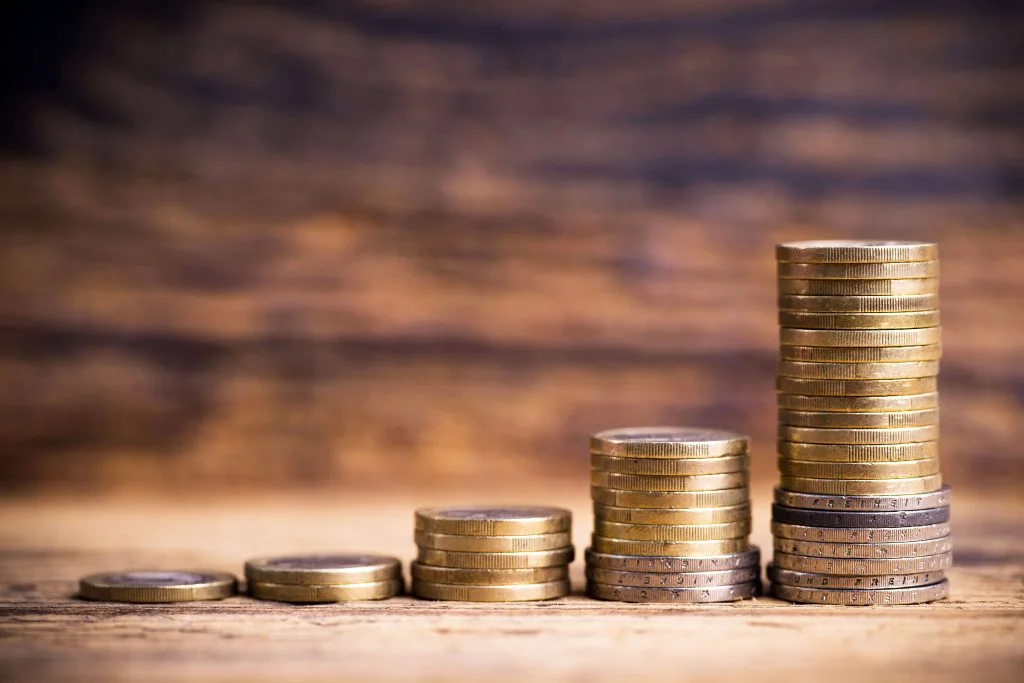WhInterest is among the most rewarding aspects of saving money. Even if you’re earning a 0.5% return on your investment the 0.5% can add to. Every penny of that interest is also earning interest.
This is also called compound interest. Interest earned on your interest is paid as you move. As interest rates rise you can gain a higher profit on the cash you’ve put aside. But compound interest operates in the opposite direction, too. If you’ve taken out a loan particularly on credit cards, that amount will accrue interest that is compounded.
Here are some things to learn about compound interest.
What is compound interest?
Compound interest is the interest that you earn on your savings or debt. When you earn interest, it is added to the original amount, called the initial principal, and future interest is applied to the principal plus all earned interest.
The opposite of compound interest is simple interest. With simple interest, no matter how much interest you accumulate in your account, the interest is based only on the initial principal amount.

How Compound Interest Works
You’ve probably heard it referred to as “the power of compound interest”. Why is it so powerful? If you earn very little interest, compounding can significantly increase your balance over time. This can happen even if you don’t deposit money into your account.
But the way interest is calculated varies from account to account. There are four main ways interest is compounded :
- Annual: With annual compounding, your interest is calculated once a year. This is the most common type of compounding. It is usually used in savings accounts and time certificates of deposit.
- Quarterly Compounding: When compounding quarterly, interest is compounded four times in a year. This means that you will receive interest in the first quarter, the second quarter interest will be based on a slightly increased amount, and so on.
- Monthly: As with quarterly compounding, with monthly compounding, your interest is calculated monthly and the next month’s interest is based on the higher amount.
- Daily: Some accounts are compounded daily so that you can increase the principal amount each day while the interest rate increases slightly.
The difference between the APR and the daily rate may be small, depending on the interest rate of your account. So, if you’re trying to decide between different account options, it’s important to use a calculator to make comparisons.
The Rule of 72
One of the best-known shortcuts for estimating how long it will take to double an investment, given a fixed compounded annual interest rate, is the Rule of 72. By dividing 72 by the annual rate of return, an investor can roughly estimate how many years it will take for an initial investment to replicate itself. For example, if an investor expects a 6% annual return on an investment, it would take approximately 12 years (72 ÷ 6 = 12) to double the investment.
It’s important to note that the Rule of 72 is a simplification that works best for interest rates between 6% and 10%. For rates beyond that range, the rule may provide distorted results. Nonetheless, it is still a handy tool for quick approximations.
Formula for Periodic Compounding Rate
You will find a lot of compound interest calculators out there, but it can help you understand the formula for compound interest. When compounding interest, the lender multiplies the current value by the interest rate and then divides it by the amount of the compounding period. So the formula is.
Current value x interest rate ÷ number of compounding periods = future value.
This is where the different compounding periods come into play. If your interest is compounded daily, the third number would be 365, while interest compounded quarterly would be 4.
How does compound interest grow over time?
One of the best things about compound interest is that you can enjoy substantial returns over a longer period of time. You don’t even need to increase the return from the initial amount. This makes it an excellent low-risk addition to an investor’s portfolio.
Let’s say you deposit $1,000 into a high-yield savings account at age 20 as a long-term investment. During the term of the deposit, you’ll enjoy a steady 3% annualized interest rate, but this rate is compounded annually.After 30 years, the opening balance will have increased to $2,427.26. That’s without depositing another penny into the account.
What happens if your interest follows a daily compounding schedule? Not much of a difference.After 30 years, your initial investment would have grown to $2,459.51, only $32.25 more than the annual compounding.
How to Calculate Compound Interest
You can use the formula above to determine how much interest you’ll earn with compounding. But there’s an easier way.
A compound interest calculator can help you estimate your expected rate of return over time. Here are three things to consider:
With a compound interest calculator, you can fiddle with various APRs and switch between quarterly or annual compounding periods to determine the exact period you need. You can also notice how small differences in interest rates can change your total interest accrual.

Who benefits from compound interest?
Just as the compound interest formula works for you when you’re saving or investing, it can also work against you when you use a credit card or loan. Credit card companies and lenders use compound interest to earn more interest on your loans.
This is another area where a compound interest calculator can help. You can process this data and compare the services offered by one lender or credit card provider to the competition. If you’re borrowing thousands or tens of thousands of dollars, the subtle difference between the interest rate calculated daily and the interest rate calculated annually can save you money.
Applying the Compound Interest Formula
Once you’ve used the formula for calculating compound interest, it’s time to figure out how to make interest work for you. You could put some money into a savings account and wait for the interest to build up, but the low interest rates on these types of accounts will ensure that the interest grows slower than if you were to put the money elsewhere.
Here are some tools that can help you get a higher rate of return by harnessing the power of compound interest:
- High Yield Savings Accounts: You can usually find a better APR on these types of savings accounts, but be aware that it will vary depending on the market.
- Money Market Accounts: If you want your money to be available at all times, money market accounts can earn a higher interest rate without locking your money in for a fixed period of time.
- Savings Bonds: With savings bonds, you lend money to a company or government entity in exchange for a fixed annual interest rate.
- Time Certificates of Deposit: While time certificates of deposit do require you to agree to lock up your money for six months to five years, they typically offer higher APRs than savings accounts and money market accounts.
- Investments: Investment returns may be higher, but so are the risks. However, with the right investment advice, you can not only enjoy the benefits of compound interest, but also reinvest any income to increase dividends.
Compound Interest Investments
For long-term growth, the stock market is a great place to see your principal balance flourish. Look for low-risk dividend stocks that will grow slowly over time. While these types of stocks don’t make as much money as more volatile stocks, you won’t lose sleep worrying about what the stock market is doing.
Another low-risk, high-yield investment option is a real estate investment trust. Short for real estate investment trust, this savings vehicle pays dividends, which are then reinvested, and the reinvested amount earns dividends. This offers compounded returns similar to savings options.
What is the difference between simple and compound interest?
Compound interest does not apply to all interest income. It varies from lender to lender. Some auto loans and short-term personal loans use something called simple interest. You’ll also find this type of interest on your student loans and mortgages.
With simple interest, the interest is based solely on the principal amount. If you borrow $1,000, you only pay interest on that $1,000. Some savings accounts use a simple interest rather than a compound interest formula. This means that any interest you earn on your deposits is eliminated.
How to Determine Interest Amount
The total amount of interest you’ve accrued will include the interest you’ve earned today, as well as previous interest. As long as you know the total principal amount, you can accurately determine how much you’ve earned from the time you deposited the money into your account to today.
The formula for calculating the total return you have earned from your investment or savings is as follows.
Present Value – Initial Amount = Total Interest Earned.
If you have been depositing money into your account since your initial investment, you need to take that into account as well. Calculating compound interest on an investment requires that you first deduct any sporadic or monthly contributions in addition to the initial deposit.
Present value – initial amount – additional money invested = total interest earned.

What is continuous compounding?
Most interest is calculated using what is known as a continuous compounding cycle. These would be daily, monthly, quarterly or annually. The interest rate only applies to previously earned interest as it reaches that milestone.
However, there is a concept known as continuous compounding. This type of compounding uses a different type of compounding frequency. Theoretically, this type of compounding occurs continuously. Continuous compounding can be used when you are trying to calculate how much your money will earn over an indeterminate period of time.
Formula for Continuous Compounding
The easiest way to calculate continuous compounding is to use an online calculator. There are several available, including one from Omni Calculator and one from Math Warehouse.
However, it can help to understand how the formula is calculated. Continuous compound interest follows the following formula.
Present value x e (i x t) = Future value
In this formula, e is the mathematical constant, which has a value of 2.7183. The mathematical constant is the number assigned to the formula. In the formula, the interest rate is denoted by “i”, which is then multiplied by the length of time it takes to earn interest, which is “t”.
What is half-yearly compounding?
Although it’s not as common as daily, monthly, quarterly or annual interest, semi-annual compounding is an option. With this type of compounding, interest is calculated and compounded every six months. So, in the second half of the year, your interest rate is higher than in the first half. This can help your balance grow faster than on an annual basis.
When you pay interest, you may see this compounding more often than when you earn it. Lenders might say semi-annually instead of half-yearly. Either way, the interest added to your balance will grow faster than if you calculated the loan once a year.
Formula for Half-Yearly Compounding
Like other types of compounding, semi-annual compounding follows a formula. In this case, the numbers are added together and divided by the number of compounding cycles, which is 2.
The easiest way to calculate semiannual compound interest is to use a calculator. You can find semi-annual compound interest calculators on calculator websites or on Calculator Soup. Simply select semiannual from the options.
If you need the formula for semiannual compounding, it is as follows.
Present value x {1+(i/2)/100)^t = Future value
In this case, “i” represents the interest rate and “t” equals the number of half-yearly periods in which the loan or savings will compound.
Continuing Contributions and Compounding
As powerful as compound interest is, there’s no better way to increase the future value of your savings and investments than by adding money to your account. As you continue to deposit money over weeks, months, and years, the interest you earn grows because the percentage applies to higher amounts.
So if you start out with a $1,000 deposit and don’t add any more money, you could grow to $2,427.26 in 30 years at a 3% interest rate, compounded annually. But if you added $10 a month over that 30-year period, your income would more than triple to an ending balance of $8,136.31.
How did it grow so fast? That’s the power of compound interest. Initially, your interest is $1,000, but the next month, your interest is $1,010. With daily compounding, you earn interest every day on top of the previous day’s interest. For annual compounding, at the end of the first year, you would earn $1,120 in interest, plus the interest you earned from that $1,120.

How can I tell if interest Is compounded?
When purchasing a new account, there is a straightforward way to determine how your interest is accruing. Look for the three letters after the rate; these letters indicate one of two things.
- APR: Abbreviation for Annual Percentage Rate, which is a simple rate that provides interest only on the principal balance.
- APY: Stands for Annual Percentage Yield, which means that interest accrues multiple times per year, whether it’s yearly, daily, weekly, monthly or quarterly.
When to Avoid Compound Interest
As a consumer, compound interest isn’t always in your favor. That’s why you’ll see “APY” behind the interest rates offered on investment and savings accounts. Financial institutions will boldly list “APR” as the rate at which you borrowed money.
If the interest rate on the credit card or loan you end up using is compounded, you’ll pay more during the repayment process. Each month you borrow money with interest, you will owe compounded interest on the principal and total accrued interest to date. This additional interest will increase over time.
Compound Interest and Retirement Planning
When considering a long-term retirement plan, compounding interest annually or monthly may be your ally. It allows you to put money away without worrying about losing it as the stock market fluctuates. If you start early, you can sometimes make more money over the course of decades than with other riskier investments, thanks to the power of compound interest.
Some experts use compound interest as a wealth creation tool. In this case, compounding occurs when an investor reinvests all earned dividends to keep those dollars working. Over time, the investor can use the earned dollars to significantly increase the original principal.
Compound Interest and Taxability
Like simple interest, compound interest counts as taxable income. At tax time, you’ll receive a form from each of your financial institutions detailing the interest you earned during the tax year. You should report these funds on your taxes.
One exception is if you keep the money in a tax-deferred account, such as a traditional IRA. This money will grow tax-free over your lifetime, with interest compounding as you grow. But when you take the money out later, you’ll have to pay taxes on all the interest. In a retirement plan, a compound interest calculator can help you figure out the total return so you can start estimating how much you’ll owe.
Interest Rates and Compounding Interest
Just as important as a feature like the frequency of compounding is to look at the interest rate you’re earning. Even one or two percentage points can make a big difference in the interest you earn on the same amount, especially if you earn interest over a 20- or 30-year period.
The same is true when you pay interest. That one or two percentage points can save you money when the interest is compounded instead of simple interest. This is especially important for large monthly payments like an auto loan or mortgage.

Interest Rate Fluctuations and Compound Interest
Unless you lock in your interest rate when you take out a loan or deposit money into a new account, your interest rate will fluctuate over the years. In fact, interest rates have been rising in 2023, which is good news if you’re investing and saving, but bad news if you’re looking for a mortgage or personal loan.
However, if your money is earning compound interest, a rate hike could be good news. The new, higher rate will apply to your principal plus all the interest you previously earned. If it goes down, you won’t lose the interest you earned when rates were higher, which means you’ll continue to benefit from the extra amount for the life of the account.
Making the Most of Compounding Interest
What’s the secret to making money with compound interest? Time. If you can put money into a compound interest account in high school or as a young adult and then save it until you retire, you’ll get the most out of it. But it’s never too late to make money from compound interest.
The key to maximizing returns from any savings or investment vehicle is to find the best terms to start with. Try to find the best compound interest rate that both meets your needs, but consider other features as well. If you have to pay a little interest on an account that is compounded monthly rather than annually, you may be able to recoup a small portion of the interest you are taking on.
Whether you’re investing or saving money in a savings account, compound interest can get you farther and faster than simple interest. The key is to choose a compound interest rate that maximizes your income and make regular deposits into that account for growth. If you’re investing, reinvesting dividends can help your income grow just as compound interest benefits your savings vehicle.




